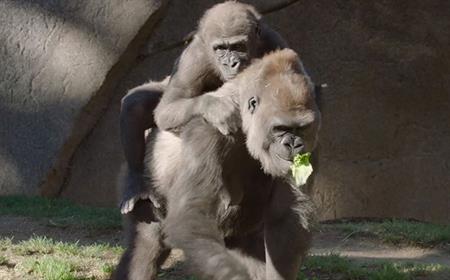Animal care specialists at the San Diego Zoo Safari Park were concerned when they noticed cloudiness in the left eye of Leslie, a 3-year-old female western lowland gorilla. Closer inspection confirmed the lens had changed and the left eye was shifting haphazardly, prompting Leslie to favor use of her right eye.
Given Leslie’s young age and developmental stage, Safari Park veterinarians organized a team of internal and external experts, including ophthalmologists and anesthesiologists at UC San Diego Health, to perform the Park’s first-ever cataract surgery on a gorilla.
“As veterinarians, we are experts in our species but we are not necessarily specialists in all of the different fields of medicine,” said Meredith Clancy, DVM, San Diego Zoo Safari Park associate veterinarian. “We rely heavily on the amazing community we have here in San Diego to help us out.”
On December 10, 2019, surrounded by animal care experts and veterinarians in khaki uniforms and UC San Diego Health medical team members in scrubs, Leslie rested comfortably in the operating room at the San Diego Zoo Global’s Paul Harter Veterinary Medical Center. A pharmaceutical muscle blocker prevented even the slightest of movement, allowing Chris W. Heichel, MD, cataract surgery specialist at Shiley Eye Institute at UC San Diego Health, to perform the delicate procedure.
Heichel and his team employed a specialized microscope and instruments designed for cataract surgery to successfully remove the cataract in Leslie’s left eye using gentle suction. Once the cloudy lens was removed, a new artificial lens was inserted, which is designed to provide Leslie with clear vision for the rest of her life.
While Heichel has performed thousands of eye surgeries on human patients, ranging in age from one day to 105 years, this was his first surgery on a gorilla.
“Fortunately, the similarities between the anatomy of human and gorilla eyes are great enough to allow us to safely navigate the procedure without complication,” said Heichel. “The remainder of the eye appeared to be in excellent health, indicating exceptional vision potential for the rest of Leslie’s life.”
A cataract is a clouding of the clear lens behind the colored part of the eye, known as the iris. Cataracts typically develop over time, as part of the normal aging process, but they can also be caused by trauma to the eye. Once a cataract develops, the lens becomes progressively cloudier and vision deteriorates.
Heichel, Clancy and animal caregivers suspect that Leslie’s cataract was a result of an injury, either from a fall while the youngster was practicing her climbing skills or from an overly rambunctious play session with other young gorillas in her troop.
As she recovers, Leslie will require both topical and oral antibiotics and steroids to prevent infection and to control postoperative inflammation, said Clancy. Leslie will be monitored closely, but she is already back with her troop in the Gorilla Forest habitat at the Safari Park.
Following successful healing, the remaining concern is the possibility of cloudiness recurring.
“The eye has an envelope that holds the lens in place. It should remain clear, but sometimes after cataract surgery, the envelope will get a little cloudy,” said Heichel, professor of ophthalmology in the Viterbi Family Department of Ophthalmology at UC San Diego School of Medicine. “In a human patient, we can laser the envelope to remove the cloudiness. That might not be quite so easy for Leslie, therefore I made a little opening in the back of the envelope to maintain her clear vision in the future. I am grateful for the chance I had to work with the exceptional San Diego Zoo Global team to help have a positive impact on Leslie’s life.”
Because of Leslie’s age, the Safari Park’s animal care team was concerned her 31-year-old mother, Kokamo, might be upset about Leslie’s absence from the gorilla habitat during the procedure. They elected to anesthetize Leslie and Kokamo at the same time, and use the opportunity to perform a routine health check on Kokamo, which included dental, cardiac and overall physical assessments. The results of Kokamo’s exam showed that she continues to be in good health.















